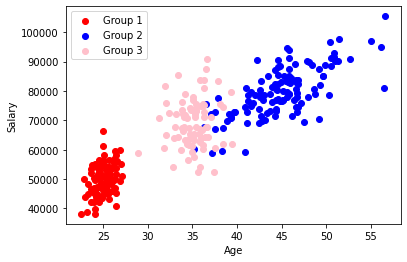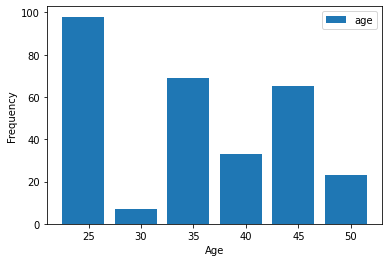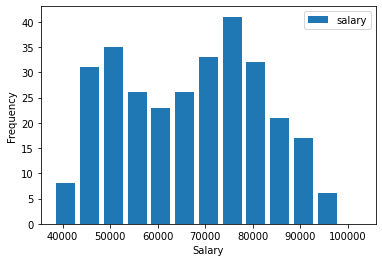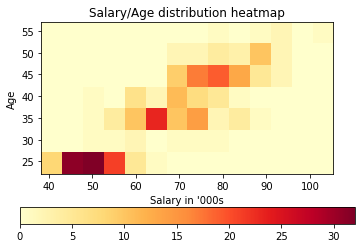Aerospike Connect for Spark Tutorial for Python
For an interactive Jupyter notebook experience 
Tested with Spark connector 3.2.0, ASDB EE 5.7.0.7, Java 8, Apache Spark 3.0.2, Python 3.7 and Scala 2.12.11 and Spylon
Setup
Ensure Database Is Running
This notebook requires that Aerospike database is running.
!asd >& /dev/null!pgrep -x asd >/dev/null && echo "Aerospike database is running!" || echo "**Aerospike database is not running!**"Output:
Aerospike database is running!
Set Aerospike, Spark, and Spark Connector Paths and Parameters
# Directorie where spark related components are installedSPARK_NB_DIR = '/opt/spark-nb'SPARK_HOME = SPARK_NB_DIR + '/spark-3.0.3-bin-hadoop3.2'# IP Address or DNS name for one host in your Aerospike clusterAS_HOST ="localhost"# Name of one of your namespaces. Type 'show namespaces' at the aql prompt if you are not sureAS_NAMESPACE = "test"AEROSPIKE_SPARK_JAR_VERSION="3.2.0"AS_PORT = 3000 # Usually 3000, but change here if notAS_CONNECTION_STRING = AS_HOST + ":"+ str(AS_PORT)# Aerospike Spark Connector settingsimport osAEROSPIKE_JAR_PATH = SPARK_NB_DIR + '/' + "aerospike-spark-assembly-" + AEROSPIKE_SPARK_JAR_VERSION + ".jar"os.environ["PYSPARK_SUBMIT_ARGS"] = '--jars ' + AEROSPIKE_JAR_PATH + ' pyspark-shell'Alternative Setup for Running Notebook in Different Environment
Please follow the instructions below instead of the setup above if you are running this notebook in a different environment from the one provided by the Aerospike Intro-Notebooks container.
# IP Address or DNS name for one host in your Aerospike clusterAS_HOST = "<seed-host-ip>"# Name of one of your namespaces. Type 'show namespaces' at the aql prompt if you are not sureAS_NAMESPACE = "<namespace>"AEROSPIKE_SPARK_JAR_VERSION="<spark-connector-version>"AS_PORT = 3000 # Usually 3000, but change here if notAS_CONNECTION_STRING = AS_HOST + ":"+ str(AS_PORT)
# Set SPARK_HOME path.SPARK_HOME = '<spark-home-dir>'
# Please download the appropriate Aeropsike Connect for Spark from the [download page](https://aerospike.com/download/connector/spark/)# Set `AEROSPIKE_JAR_PATH` with path to the downloaded binaryimport osAEROSPIKE_JAR_PATH= "<aerospike-jar-dir>/aerospike-spark-assembly-"+AEROSPIKE_SPARK_JAR_VERSION+".jar"os.environ["PYSPARK_SUBMIT_ARGS"] = '--jars ' + AEROSPIKE_JAR_PATH + ' pyspark-shell'Spark Initialization
# Next we locate the Spark installation - this will be found using the SPARK_HOME environment variable that you will have set
import findsparkfindspark.init(SPARK_HOME)import pysparkfrom pyspark.sql.types import *Configure Aerospike properties in the Spark Session object. Please visit Configuring Aerospike Connect for Spark for more information about the properties used on this page.
from pyspark.sql import SparkSessionfrom pyspark import SparkContextsc = SparkContext.getOrCreate()conf=sc._conf.setAll([("aerospike.namespace",AS_NAMESPACE),("aerospike.seedhost",AS_CONNECTION_STRING), ("aerospike.log.level","info")])sc.stop()sc = pyspark.SparkContext(conf=conf)spark = SparkSession(sc)# sqlContext = SQLContext(sc)Schema in the Spark Connector
-
Aerospike is schemaless, however Spark adheres to a schema. After the schema is decided upon (either through inference or given), data within the bins must honor the types.
-
To infer schema, the connector samples a set of records (configurable through
aerospike.schema.scan) to decide the name of bins/columns and their types. This implies that the derived schema depends entirely upon sampled records. -
Note that
__keywas not part of provided schema. So how can one query using__key? We can just add__keyin provided schema with appropriate type. Similarly we can add__gen,__ttl, or other columns.schemaWithPK = StructType([ StructField(“__key”,IntegerType(), False), StructField(“id”, IntegerType(), False), StructField(“name”, StringType(), False), StructField(“age”, IntegerType(), False), StructField(“salary”,IntegerType(), False)])
-
We recommend that you provide schema for queries that involve collection data types such as lists, maps, and mixed types. Using schema inference for CDT may cause unexpected issues.
Flexible schema inference
Spark assumes that the underlying data store (Aerospike in this case) follows a strict schema for all the records within a table. However, Aerospike is a No-SQL DB and is schemaless. For further information on the Spark connector reconciles those differences, visit Flexible schema page
- aerospike.schema.flexible = true (default)
- aerospike.schema.flexible = false
import randomnum_records=200
schema = StructType( [ StructField("id", IntegerType(), True), StructField("name", StringType(), True) ])
inputBuf = []for i in range(1, num_records) : name = "name" + str(i) id_ = i inputBuf.append((id_, name))
inputRDD = spark.sparkContext.parallelize(inputBuf)inputDF=spark.createDataFrame(inputRDD,schema)
#Write the Sample Data to AerospikeinputDF \.write \.mode('overwrite') \.format("aerospike") \.option("aerospike.writeset", "py_input_data")\.option("aerospike.updateByKey", "id") \.save()aerospike.schema.flexible = true (default)
If none of the column types in the user-specified schema match the bin types of a record in Aerospike, a record with NULLs is returned in the result set.
Use the filter() in Spark to filter out NULL records. For example, df.filter(“gender == NULL”).show(false), where df is a dataframe and gender is a field that was not specified in the user-specified schema.
If the mismatch is limited to fewer columns in the user-specified schema, then NULL is returned for those columns in the result set.
The columns that are not a part of the schema are automatically filtered out in the result set by the connector.
If any field is set to nullable = false, your query will error out if there is a type mismatch between an Aerospike bin and the column type specified in the user-specified schema.
schemaIncorrect = StructType( [ StructField("id", IntegerType(), True), StructField("name", IntegerType(), True) ##Note incorrect type of name bin ])
flexSchemaInference=spark \.read \.format("aerospike") \.schema(schemaIncorrect) \.option("aerospike.set", "py_input_data").load()
flexSchemaInference.show(5)
##notice all the contents of name column is null due to schema mismatch and aerospike.schema.flexible = true (by default)Output:
+---+----+ |_id|name| +---+----+ | 10|null| | 50|null| |185|null| |117|null| | 88|null| +---+----+ only showing top 5 rows
aerospike.schema.flexible = false
If a mismatch between the user-specified schema and the schema of a record in Aerospike is detected at the bin/column level, your query will error out.
#When strict matching is set, we will get an exception due to type mismatch with schema provided.
try: errorDFStrictSchemaInference=spark \ .read \ .format("aerospike") \ .schema(schemaIncorrect) \ .option("aerospike.schema.flexible" ,"false") \ .option("aerospike.set", "py_input_data").load() errorDFStrictSchemaInference.show(5)except Exception as e: pass
#This will throw error due to type mismatchCreate sample data
# We create age vs salary data, using three different Gaussian distributionsimport numpy as npimport matplotlib.pyplot as pltimport pandas as pdimport math
# Make sure we get the same results every time this workbook is run# Otherwise we are occasionally exposed to results not working out as expectednp.random.seed(12345)
# Create covariance matrix from std devs + correlationdef covariance_matrix(std_dev_1,std_dev_2,correlation): return [[std_dev_1 ** 2, correlation * std_dev_1 * std_dev_2], [correlation * std_dev_1 * std_dev_2, std_dev_2 ** 2]]
# Return a bivariate sample given means/std dev/correlationdef age_salary_sample(distribution_params,sample_size): mean = [distribution_params["age_mean"], distribution_params["salary_mean"]] cov = covariance_matrix(distribution_params["age_std_dev"],distribution_params["salary_std_dev"], distribution_params["age_salary_correlation"]) return np.random.multivariate_normal(mean, cov, sample_size).T
# Define the characteristics of our age/salary distributionage_salary_distribution_1 = {"age_mean":25,"salary_mean":50000, "age_std_dev":1,"salary_std_dev":5000,"age_salary_correlation":0.3}
age_salary_distribution_2 = {"age_mean":45,"salary_mean":80000, "age_std_dev":4,"salary_std_dev":8000,"age_salary_correlation":0.7}
age_salary_distribution_3 = {"age_mean":35,"salary_mean":70000, "age_std_dev":2,"salary_std_dev":9000,"age_salary_correlation":0.1}
distribution_data = [age_salary_distribution_1,age_salary_distribution_2,age_salary_distribution_3]
# Sample age/salary data for each distributionssample_size_1 = 100;sample_size_2 = 120;sample_size_3 = 80;sample_sizes = [sample_size_1,sample_size_2,sample_size_3]group_1_ages,group_1_salaries = age_salary_sample(age_salary_distribution_1,sample_size=sample_size_1)group_2_ages,group_2_salaries = age_salary_sample(age_salary_distribution_2,sample_size=sample_size_2)group_3_ages,group_3_salaries = age_salary_sample(age_salary_distribution_3,sample_size=sample_size_3)
ages=np.concatenate([group_1_ages,group_2_ages,group_3_ages])salaries=np.concatenate([group_1_salaries,group_2_salaries,group_3_salaries])
print("Data created")Output:
Data created
Display simulated age/salary data
# Plot the sample datagroup_1_colour, group_2_colour, group_3_colour ='red','blue', 'pink'plt.xlabel('Age',fontsize=10)plt.ylabel("Salary",fontsize=10)
plt.scatter(group_1_ages,group_1_salaries,c=group_1_colour,label="Group 1")plt.scatter(group_2_ages,group_2_salaries,c=group_2_colour,label="Group 2")plt.scatter(group_3_ages,group_3_salaries,c=group_3_colour,label="Group 3")
plt.legend(loc='upper left')plt.show()
Save data to Aerospike
# Turn the above records into a Data Frame# First of all, create an array of arraysinputBuf = []
for i in range(0, len(ages)) : id = i + 1 # Avoid counting from zero name = "Individual: {:03d}".format(id) # Note we need to make sure values are typed correctly # salary will have type numpy.float64 - if it is not cast as below, an error will be thrown age = float(ages[i]) salary = int(salaries[i]) inputBuf.append((id, name,age,salary))
# Convert to an RDDinputRDD = spark.sparkContext.parallelize(inputBuf)
# Convert to a data frame using a schemaschema = StructType([ StructField("id", IntegerType(), True), StructField("name", StringType(), True), StructField("age", DoubleType(), True), StructField("salary",IntegerType(), True)])
inputDF=spark.createDataFrame(inputRDD,schema)
#Write the data frame to Aerospike, the id field is used as the primary keyinputDF \.write \.mode('overwrite') \.format("aerospike") \.option("aerospike.set", "salary_data")\.option("aerospike.updateByKey", "id") \.save()Using Spark SQL syntax to insert data
#Aerospike DB needs a Primary key for record insertion. Hence, you must identify the primary key column#using for example .option(“aerospike.updateByKey”, “id”), where “id” is the name of the column that you’d#like to be the Primary key, while loading data from the DB.
insertDFWithSchema=spark \.read \.format("aerospike") \.schema(schema) \.option("aerospike.set", "salary_data") \.option("aerospike.updateByKey", "id") \.load()
sqlView="inserttable"
## V2 datasource doesn't allow insert into a view.#insertDFWithSchema.createTempView(sqlView)spark.sql("select * from inserttable").show()Output:
+---+---------------+------------------+------+ | id| name| age|salary| +---+---------------+------------------+------+ |239|Individual: 239|34.652141285212814| 61747| |101|Individual: 101| 46.53337694047583| 89019| |194|Individual: 194| 45.57430980213641| 94548| | 31|Individual: 031| 25.24920420954561| 54312| |139|Individual: 139| 38.84745269824979| 69645| | 14|Individual: 014| 25.59043077849547| 51513| |142|Individual: 142| 42.56064799325679| 80357| |272|Individual: 272| 33.97918907293992| 66496| | 76|Individual: 076|25.457857266022888| 46214| |147|Individual: 147| 43.1868235157955| 70158| | 79|Individual: 079|25.887490702675926| 48162| | 96|Individual: 096| 24.08476170165959| 46328| |132|Individual: 132| 50.30396237031055| 78746| | 10|Individual: 010|25.082338749020725| 58345| |141|Individual: 141| 43.67491677796684| 79076| |140|Individual: 140| 43.06512046705784| 78500| |160|Individual: 160| 54.98712625322746| 97029| |112|Individual: 112| 37.09568187885061| 72307| |120|Individual: 120|45.189080979167926| 80007| | 34|Individual: 034| 22.79485298523146| 49882| +---+---------------+------------------+------+ only showing top 20 rows
Load data into a DataFrame without specifying any Schema (uses schema inference)
# Create a Spark DataFrame by using the Connector Schema inference mechanism# The fields preceded with __ are metadata fields - key/digest/expiry/generation/ttl# By default you just get everything, with no column ordering, which is why it looks untidy# Note we don't get anything in the 'key' field as we have not chosen to save as a bin.# Use .option("aerospike.sendKey", True) to do this
loadedDFWithoutSchema = ( spark.read.format("aerospike") \ .option("aerospike.set", "salary_data") \ .load())
loadedDFWithoutSchema.show(10)Output:
+-----+--------------------+--------+------------+-----+------------------+---------------+------+---+ |__key| __digest|__expiry|__generation|__ttl| age| name|salary| id| +-----+--------------------+--------+------------+-----+------------------+---------------+------+---+ | null|[03 50 2E 7F 70 9…| 0| 1| -1|34.652141285212814|Individual: 239| 61747|239| | null|[04 C0 5E 9A 68 5…| 0| 1| -1| 46.53337694047583|Individual: 101| 89019|101| | null|[0F 10 1A 93 B1 E…| 0| 1| -1| 45.57430980213641|Individual: 194| 94548|194| | null|[1A E0 A8 A0 F2 3…| 0| 1| -1| 25.24920420954561|Individual: 031| 54312| 31| | null|[23 20 78 35 5D 7…| 0| 1| -1| 38.84745269824979|Individual: 139| 69645|139| | null|[35 00 8C 78 43 F…| 0| 1| -1| 25.59043077849547|Individual: 014| 51513| 14| | null|[37 00 6D 21 08 9…| 0| 1| -1| 42.56064799325679|Individual: 142| 80357|142| | null|[59 00 4B C7 6D 9…| 0| 1| -1| 33.97918907293992|Individual: 272| 66496|272| | null|[61 50 89 B1 EC 0…| 0| 1| -1|25.457857266022888|Individual: 076| 46214| 76| | null|[6C 50 7F 9B FD C…| 0| 1| -1| 43.1868235157955|Individual: 147| 70158|147| +-----+--------------------+--------+------------+-----+------------------+---------------+------+---+ only showing top 10 rows
Load data into a DataFrame using user specified schema
# If we explicitly set the schema, using the previously created schema object# we effectively type the rows in the Data Frame
loadedDFWithSchema=spark \.read \.format("aerospike") \.schema(schema) \.option("aerospike.set", "salary_data").load()
loadedDFWithSchema.show(5)Output:
+---+---------------+------------------+------+ | id| name| age|salary| +---+---------------+------------------+------+ |239|Individual: 239|34.652141285212814| 61747| |101|Individual: 101| 46.53337694047583| 89019| |194|Individual: 194| 45.57430980213641| 94548| | 31|Individual: 031| 25.24920420954561| 54312| |139|Individual: 139| 38.84745269824979| 69645| +---+---------------+------------------+------+ only showing top 5 rows
Sampling from Aerospike DB
-
Sample specified number of records from Aerospike to considerably reduce data movement between Aerospike and the Spark clusters. Depending on the aerospike.partition.factor setting, you may get more records than desired. Please use this property in conjunction with Spark
limit()function to get the specified number of records. The sample read is not randomized, so sample more than you need and use the Sparksample()function to randomize if you see fit. You can use it in conjunction withaerospike.recordspersecondto control the load on the Aerospike server while sampling. -
For more information, please see documentation page.
#number_of_spark_partitions (num_sp)=2^{aerospike.partition.factor}#total number of records = Math.ceil((float)aerospike.sample.size/num_sp) * (num_sp)#use lower partition factor for more accurate samplingsetname="py_input_data"sample_size=101
df3=spark.read.format("aerospike") \.option("aerospike.partition.factor","2") \.option("aerospike.set",setname) \.option("aerospike.sample.size","101") \.load()
df4=spark.read.format("aerospike") \.option("aerospike.partition.factor","6") \.option("aerospike.set",setname) \.option("aerospike.sample.size","101") \.load()
#Notice that more records were read than requested due to the underlying partitioning logic related to the partition factor as described earlier, hence we use Spark limit() function additionally to return the desired number of records.count3=df3.count()count4=df4.count()
#Note how limit got only 101 records from df4.dfWithLimit=df4.limit(101)limitCount=dfWithLimit.count()
print("count3= ", count3, " count4= ", count4, " limitCount=", limitCount)Output:
count3= 104 count4= 113 limitCount= 101
Working with Collection Data Types (CDT) in Aerospike
Save JSON into Aerospike using a schema
# Schema specificationaliases_type = StructType([ StructField("first_name",StringType(),False), StructField("last_name",StringType(),False)])
id_type = StructType([ StructField("first_name",StringType(),False), StructField("last_name",StringType(),False), StructField("aliases",ArrayType(aliases_type),False)])
street_adress_type = StructType([ StructField("street_name",StringType(),False), StructField("apt_number",IntegerType(),False)])
address_type = StructType([ StructField("zip",LongType(),False), StructField("street",street_adress_type,False), StructField("city",StringType(),False)])
workHistory_type = StructType([ StructField ("company_name",StringType(),False), StructField( "company_address",address_type,False), StructField("worked_from",StringType(),False)])
person_type = StructType([ StructField("name",id_type,False), StructField("SSN",StringType(),False), StructField("home_address",ArrayType(address_type),False), StructField("work_history",ArrayType(workHistory_type),False)])
# JSON data locationcomplex_data_json="resources/nested_data.json"
# Read data in using prepared schemacmplx_data_with_schema=spark.read.schema(person_type).json(complex_data_json)
# Save data to Aerospikecmplx_data_with_schema \.write \.mode('overwrite') \.format("aerospike") \.option("aerospike.writeset", "complex_input_data") \.option("aerospike.updateByKey", "SSN") \.save()Retrieve CDT from Aerospike into a DataFrame using schema
loadedComplexDFWithSchema=spark \.read \.format("aerospike") \.option("aerospike.set", "complex_input_data") \.schema(person_type) \.load()loadedComplexDFWithSchema.show(5)Output:
+--------------------+-----------+--------------------+--------------------+ | name| SSN| home_address| work_history| +--------------------+-----------+--------------------+--------------------+ |[Carrie, Collier,…|611-70-8032|[[14908, [Frankli…|[[Russell Group, …| |[Ashley, Davis, […|708-19-4933|[[44679, [Duarte …|[[Gaines LLC, [57…| |[Anthony, Dalton,…|466-55-4994|[[48032, [Mark Es…|[[Mora, Sherman a…| |[Jennifer, Willia…|438-70-6995|[[6917, [Gates Vi…|[[Cox, Olsen and …| |[Robert, Robinson…|561-49-6700|[[29209, [Hernand…|[[Frye, Mckee and…| +--------------------+-----------+--------------------+--------------------+ only showing top 5 rows
Data Exploration with Aerospike
import pandasimport matplotlibimport matplotlib.pyplot as plt
#convert Spark df to pandas dfpdf = loadedDFWithSchema.toPandas()
# Describe the data
pdf.describe()| id | age | salary | |
|---|---|---|---|
| count | 300.000000 | 300.000000 | 300.000000 |
| mean | 150.500000 | 35.671508 | 66952.626667 |
| std | 86.746758 | 8.985810 | 14876.009907 |
| min | 1.000000 | 22.513878 | 38148.000000 |
| 25% | 75.750000 | 25.773766 | 53387.000000 |
| 50% | 150.500000 | 35.651953 | 69062.500000 |
| 75% | 225.250000 | 44.030919 | 78533.750000 |
| max | 300.000000 | 56.636219 | 105414.000000 |
#Histogram - Ageage_min, age_max = int(np.amin(pdf['age'])), math.ceil(np.amax(pdf['age']))age_bucket_size = 5print(age_min,age_max)pdf[['age']].plot(kind='hist',bins=range(age_min,age_max,age_bucket_size),rwidth=0.8)plt.xlabel('Age',fontsize=10)plt.legend(loc=None)plt.show()
#Histogram - Salarysalary_min, salary_max = int(np.amin(pdf['salary'])), math.ceil(np.amax(pdf['salary']))salary_bucket_size = 5000pdf[['salary']].plot(kind='hist',bins=range(salary_min,salary_max,salary_bucket_size),rwidth=0.8)plt.xlabel('Salary',fontsize=10)plt.legend(loc=None)plt.show()
# Heatmapage_bucket_count = math.ceil((age_max - age_min)/age_bucket_size)salary_bucket_count = math.ceil((salary_max - salary_min)/salary_bucket_size)
x = [[0 for i in range(salary_bucket_count)] for j in range(age_bucket_count)]for i in range(len(pdf['age'])): age_bucket = math.floor((pdf['age'][i] - age_min)/age_bucket_size) salary_bucket = math.floor((pdf['salary'][i] - salary_min)/salary_bucket_size) x[age_bucket][salary_bucket] += 1
plt.title("Salary/Age distribution heatmap")plt.xlabel("Salary in '000s")plt.ylabel("Age")
plt.imshow(x, cmap='YlOrRd', interpolation='nearest',extent=[salary_min/1000,salary_max/1000,age_min,age_max], origin="lower")plt.colorbar(orientation="horizontal")plt.show()Output:
22 57



Note:
- Queries that involve Primary Key or Digest in the predicate trigger aerospike_batch_get()(/develop/client/python/usage/batch) and run extremely quickly. For example, a query containing
__keyor__digestwith noORbetween two bins. - All other queries may entail a full scan of the Aerospike DB if they can’t be converted to Aerospike batchget.
Queries that include Primary Key in the Predicate
With batch get queries we can apply filters on metadata columns such as __gen or __ttl. To do this, these columns should be exposed through the schema.
# Basic PKey querybatchGet1= spark \.read \.format("aerospike") \.option("aerospike.set", "salary_data") \.option("aerospike.keyType", "int") \.load().where("__key = 100") \
batchGet1.show()#Note ASDB only supports equality test with PKs in primary key query.#So, a where clause with "__key >10", would result in scan query!Output
+-----+--------------------+--------+------------+-----+------------------+---------------+------+---+ |__key| __digest|__expiry|__generation|__ttl| age| name|salary| id| +-----+--------------------+--------+------------+-----+------------------+---------------+------+---+ | 100|[82 46 D4 AF BB 7…| 0| 1| -1|25.629637577191232|Individual: 100| 56483|100| +-----+--------------------+--------+------------+-----+------------------+---------------+------+---+
# Batch get, primary key based queryfrom pyspark.sql.functions import colsomePrimaryKeys= list(range(1,10))someMoreKeys= list(range(12,14))batchGet2= spark \.read \.format("aerospike") \.option("aerospike.set", "salary_data") \.option("aerospike.keyType", "int") \.load().where((col("__key").isin(somePrimaryKeys)) | ( col("__key").isin(someMoreKeys)))
batchGet2.show(5)Output
+-----+--------------------+--------+------------+-----+------------------+---------------+------+---+ |__key| __digest|__expiry|__generation|__ttl| age| name|salary| id| +-----+--------------------+--------+------------+-----+------------------+---------------+------+---+ | 13|[27 B2 50 19 5B 5…| 0| 1| -1|24.945277952954463|Individual: 013| 47114| 13| | 5|[CC 73 E2 C2 23 2…| 0| 1| -1|26.419729731447458|Individual: 005| 53845| 5| | 1|[85 36 18 55 4C B…| 0| 1| -1| 25.39547052370498|Individual: 001| 48976| 1| | 9|[EB 86 7C 94 AA 4…| 0| 1| -1|24.044793613588553|Individual: 009| 39991| 9| | 3|[B1 E9 BC 33 C7 9…| 0| 1| -1|26.918958635987888|Individual: 003| 59828| 3| +-----+--------------------+--------+------------+-----+------------------+---------------+------+---+ only showing top 5 rows
batchget query using __digest
__digestcan have only two typesBinaryType(default type) orStringType.- If schema is not provided and
__digestisStringType, then setaerospike.digestTypetostring. - Records retrieved with the
__digestbatchget call have a null primary key__key.
#convert digests to a list of byte[]digest_list=batchGet2.select("__digest").rdd.flatMap(lambda x: x).collect()
#convert digest to hex string for querying. Only digests of type hex string and byte[] array are allowed.string_digest=[ ''.join(format(x, '02x') for x in m) for m in digest_list]
#option("aerospike.digestType", "string") hints to assume that __digest type is string in schema inference.#please note that __key retrieved in this case is null. So be careful to use retrieved keys in downstream query!batchGetWithDigest= spark \.read \.format("aerospike") \.option("aerospike.set", "salary_data") \.option("aerospike.digestType", "string") \.load().where(col("__digest").isin(string_digest))batchGetWithDigest.show()
#digests can be mixed with primary keys as wellbatchGetWithDigestAndKey= spark \.read \.format("aerospike") \.option("aerospike.set", "salary_data") \.option("aerospike.digestType", "string") \.option("aerospike.keyType", "int") \.load().where(col("__digest").isin(string_digest[0:1]) | ( col("__key").isin(someMoreKeys)))batchGetWithDigestAndKey.show()#please note to the null in key columns in both dataframeOutput:
+-----+--------------------+--------+------------+-----+------------------+---------------+------+---+ |__key| __digest|__expiry|__generation|__ttl| age| name|salary| id| +-----+--------------------+--------+------------+-----+------------------+---------------+------+---+ | null|27b250195b5a5ba13…| 0| 1| -1|24.945277952954463|Individual: 013| 47114| 13| | null|cc73e2c2232b35c49…| 0| 1| -1|26.419729731447458|Individual: 005| 53845| 5| | null|853618554cb05c351…| 0| 1| -1| 25.39547052370498|Individual: 001| 48976| 1| | null|eb867c94aa487a039…| 0| 1| -1|24.044793613588553|Individual: 009| 39991| 9| | null|b1e9bc33c79b69e5c…| 0| 1| -1|26.918958635987888|Individual: 003| 59828| 3| | null|5a4a6223f73814afe…| 0| 1| -1| 24.06564069303854|Individual: 006| 55035| 6| | null|db4ab2ffe4642f01c…| 0| 1| -1|25.300866461172024|Individual: 007| 51374| 7| | null|86bbb52ef3b7d61eb…| 0| 1| -1|24.314035458986748|Individual: 002| 47402| 2| | null|f84bdce243c7f1305…| 0| 1| -1|26.251474759555812|Individual: 008| 56764| 8| | null|849cbbf34c5ca14ab…| 0| 1| -1| 25.000494245766|Individual: 012| 66244| 12| | null|91dc5e91d4b9060f6…| 0| 1| -1| 25.29664106310324|Individual: 004| 50464| 4| +-----+--------------------+--------+------------+-----+------------------+---------------+------+---+
+-----+--------------------+--------+------------+-----+------------------+---------------+------+---+ |__key| __digest|__expiry|__generation|__ttl| age| name|salary| id| +-----+--------------------+--------+------------+-----+------------------+---------------+------+---+ | null|27b250195b5a5ba13…| 0| 1| -1|24.945277952954463|Individual: 013| 47114| 13| | 12|849cbbf34c5ca14ab…| 0| 1| -1| 25.000494245766|Individual: 012| 66244| 12| +-----+--------------------+--------+------------+-----+------------------+---------------+------+---+
Queries including non-primary key conditions
# This query will run as a scan, which will be slowersomePrimaryKeys= list(range(1,10))scanQuery1= spark \.read \.format("aerospike") \.option("aerospike.set", "salary_data") \.option("aerospike.keyType", "int") \.load().where((col("__key").isin(somePrimaryKeys)) | ( col("age") >50 ))
scanQuery1.show()Output
+-----+--------------------+--------+------------+-----+------------------+---------------+------+---+ |__key| __digest|__expiry|__generation|__ttl| age| name|salary| id| +-----+--------------------+--------+------------+-----+------------------+---------------+------+---+ | null|[9A 80 6A A1 FC C…| 0| 1| -1| 50.30396237031055|Individual: 132| 78746|132| | null|[EF A0 76 41 51 B…| 0| 1| -1| 54.98712625322746|Individual: 160| 97029|160| | null|[6E 92 74 77 95 D…| 0| 1| -1| 56.51623471593592|Individual: 196| 80848|196| | null|[71 65 79 9E 25 9…| 0| 1| -1| 50.4687163424899|Individual: 162| 96742|162| | null|[7C 66 F5 9E 99 6…| 0| 1| -1| 50.5714412429367|Individual: 156| 88377|156| | null|[7E A6 1C 30 4F 9…| 0| 1| -1| 50.58123004549133|Individual: 203| 91326|203| | null|[AB AA F1 86 BF C…| 0| 1| -1| 50.8215535658812|Individual: 106| 91658|106| | null|[BC 6A 1B 19 1A 9…| 0| 1| -1|50.832911548188235|Individual: 187| 92796|187| | null|[0E 7B 68 E5 9C 9…| 0| 1| -1| 52.63646076333807|Individual: 149| 90797|149| | null|[9E 5B 71 28 56 3…| 0| 1| -1| 51.04052349344122|Individual: 214| 90306|214| | null|[28 CC 1A A7 5E 2…| 0| 1| -1|56.144545656054575|Individual: 220| 94943|220| | null|[DF 6D 03 6F 18 2…| 0| 1| -1|51.405636565306544|Individual: 193| 97698|193| | null|[4B AF 54 1F E5 2…| 0| 1| -1| 51.28350713525773|Individual: 178| 90077|178| | null|[FD DF 68 1A 00 E…| 0| 1| -1| 56.6362187203851|Individual: 206|105414|206| +-----+--------------------+--------+------------+-----+------------------+---------------+------+---+
Pushdown Aerospike Expressions from within a Spark API.
- Make sure that you do not use no the WHERE clause or spark filters while querying
- See Aerospike Expressions for more information on how to construct expressions.
- Constructed expressions must be converted to Base64 before using them in the Spark API
scala_predexp= sc._jvm.com.aerospike.spark.utility.AerospikePushdownExpressions
#id % 5 == 0 => get rows where mod(col("id")) ==0#Equvalent java Exp: Exp.eq(Exp.mod(Exp.intBin("a"), Exp.`val`(5)), Exp.`val`(0))expIntBin=scala_predexp.intBin("id") # id is the name of columnexpMODIntBinEqualToZero=scala_predexp.eq(scala_predexp.mod(expIntBin, scala_predexp.val(5)),scala_predexp.val(0))expMODIntBinToBase64= scala_predexp.build(expMODIntBinEqualToZero).getBase64()#expMODIntBinToBase64= "kwGTGpNRAqJpZAUA"pushdownset = "py_input_data"
pushDownDF =spark\ .read \ .format("aerospike") \ .schema(schema) \ .option("aerospike.set", pushdownset) \ .option("aerospike.pushdown.expressions", expMODIntBinToBase64) \ .load()
pushDownDF.count() #should get 39 records, we have 199/5 records whose id bin is divisble by 5Output:
39
pushDownDF.show(2)Output:
+---+------+----+------+ | id| name| age|salary| +---+------+----+------+ | 10|name10|null| null| | 50|name50|null| null| +---+------+----+------+ only showing top 2 rows
Parameters for tuning Aerospike / Spark performance
- aerospike.partition.factor: number of logical aerospike partitions [0-15]
- aerospike.maxthreadcount : maximum number of threads to use for writing data into Aerospike
- aerospike.compression : compression of java client-server communication
- aerospike.batchMax : maximum number of records per read request (default 5000)
- aerospike.recordspersecond : same as java client
Other useful parameters
- aerospike.keyType : Primary key type hint for schema inference. Always set it properly if primary key type is not string
See Spark connector for detailed description of the above properties
In this section we use the data we took from Aerospike and apply a clustering algorithm to it.
We assume the data is composed of multiple data sets having a Gaussian multi-variate distribution
We don’t know how many clusters there are, so we try clustering based on the assumption there are 1 through 20.
We compare the quality of the results using the Bayesian Information Criterion - https://en.wikipedia.org/wiki/Bayesian_information_criterion and pick the best.
Find Optimal Cluster Count
from sklearn.mixture import GaussianMixture
# We take the data we previouslyages=pdf['age']salaries=pdf['salary']#age_salary_matrix=np.matrix([ages,salaries]).Tage_salary_matrix=np.asarray([ages,salaries]).T
# Find the optimal number of clustersoptimal_cluster_count = 1best_bic_score = GaussianMixture(1).fit(age_salary_matrix).bic(age_salary_matrix)
for count in range(1,20): gm=GaussianMixture(count) gm.fit(age_salary_matrix) if gm.bic(age_salary_matrix) < best_bic_score: best_bic_score = gm.bic(age_salary_matrix) optimal_cluster_count = count
print("Optimal cluster count found to be "+str(optimal_cluster_count))Output:
> Optimal cluster count found to be 4Estimate cluster distribution parameters
Next we fit our cluster using the optimal cluster count, and print out the discovered means and covariance matrix
gm = GaussianMixture(optimal_cluster_count)gm.fit(age_salary_matrix)
estimates = []# Indexfor index in range(0,optimal_cluster_count): estimated_mean_age = round(gm.means_[index][0],2) estimated_mean_salary = round(gm.means_[index][1],0) estimated_age_std_dev = round(math.sqrt(gm.covariances_[index][0][0]),2) estimated_salary_std_dev = round(math.sqrt(gm.covariances_[index][1][1]),0) estimated_correlation = round(gm.covariances_[index][0][1] / ( estimated_age_std_dev * estimated_salary_std_dev ),3) row = [estimated_mean_age,estimated_mean_salary,estimated_age_std_dev,estimated_salary_std_dev,estimated_correlation] estimates.append(row)
pd.DataFrame(estimates,columns = ["Est Mean Age","Est Mean Salary","Est Age Std Dev","Est Salary Std Dev","Est Correlation"])| Est Mean Age | Est Mean Salary | Est Age Std Dev | Est Salary Std Dev | Est Correlation | |
|---|---|---|---|---|---|
| 0 | 47.24 | 87827.0 | 3.98 | 6091.0 | 0.735 |
| 1 | 25.05 | 49897.0 | 1.06 | 5185.0 | 0.398 |
| 2 | 44.37 | 76736.0 | 3.32 | 4534.0 | 0.415 |
| 3 | 35.43 | 68712.0 | 1.85 | 7966.0 | -0.028 |
Original Distribution Parameters
distribution_data_as_rows = []for distribution in distribution_data: row = [distribution['age_mean'],distribution['salary_mean'],distribution['age_std_dev'], distribution['salary_std_dev'],distribution['age_salary_correlation']] distribution_data_as_rows.append(row)
pd.DataFrame(distribution_data_as_rows,columns = ["Mean Age","Mean Salary","Age Std Dev","Salary Std Dev","Correlation"])| Mean Age | Mean Salary | Age Std Dev | Salary Std Dev | Correlation | |
|---|---|---|---|---|---|
| 0 | 25 | 50000 | 1 | 5000 | 0.3 |
| 1 | 45 | 80000 | 4 | 8000 | 0.7 |
| 2 | 35 | 70000 | 2 | 9000 | 0.1 |
You can see that the algorithm provides good estimates of the original parameters
Prediction
We generate new age/salary pairs for each of the distributions and look at how accurate the prediction is
def prediction_accuracy(model,age_salary_distribution,sample_size): # Generate new values new_ages,new_salaries = age_salary_sample(age_salary_distribution,sample_size) #new_age_salary_matrix=np.matrix([new_ages,new_salaries]).T new_age_salary_matrix=np.asarray([new_ages,new_salaries]).T # Find which cluster the mean would be classified into #mean = np.matrix([age_salary_distribution['age_mean'],age_salary_distribution['salary_mean']]) #mean = np.asarray([age_salary_distribution['age_mean'],age_salary_distribution['salary_mean']]) mean = np.asarray(np.matrix([age_salary_distribution['age_mean'],age_salary_distribution['salary_mean']])) mean_cluster_index = model.predict(mean)[0] # How would new samples be classified classification = model.predict(new_age_salary_matrix) # How many were classified correctly correctly_classified = len([ 1 for x in classification if x == mean_cluster_index]) return correctly_classified / sample_size
prediction_accuracy_results = [None for x in range(3)]for index, age_salary_distribution in enumerate(distribution_data): prediction_accuracy_results[index] = prediction_accuracy(gm,age_salary_distribution,1000)
overall_accuracy = sum(prediction_accuracy_results)/ len(prediction_accuracy_results)print("Accuracies for each distribution : "," ,".join(map('{:.2%}'.format,prediction_accuracy_results)))print("Overall accuracy : ",'{:.2%}'.format(overall_accuracy))Output
> Accuracies for each distribution : 100.00% ,60.20% ,98.00%> Overall accuracy : 86.07%aerolookup
aerolookup allows you to look up records corresponding to a set of keys stored in a Spark DF, streaming or otherwise. It supports:
- Aerospike CDT
- Quota and retry (these configurations are extracted from sparkconf)
- Flexible schema. To enable, set
aerospike.schema.flexibleto true in the SparkConf object. - Aerospike Expressions Pushdown (Note: This must be specified through SparkConf object.)
alias = StructType([StructField("first_name", StringType(), False), StructField("last_name", StringType(), False)])name = StructType([StructField("first_name", StringType(), False), StructField("aliases", ArrayType(alias), False)])street_adress = StructType([StructField("street_name", StringType(), False), StructField("apt_number", IntegerType(), False)])address = StructType([StructField("zip", LongType(), False), StructField("street", street_adress, False), StructField("city", StringType(), False)])work_history = StructType([StructField("company_name", StringType(), False), StructField("company_address", address, False), StructField("worked_from", StringType(), False)])
output_schema = StructType([StructField("name", name, False), StructField("SSN", StringType(), False), StructField("home_address", ArrayType(address), False)])
ssns = [["825-55-3247"], ["289-18-1554"], ["756-46-4088"], ["525-31-0299"], ["456-45-2200"], ["200-71-7765"]]
#Create a set of PKs whose records you'd like to look up in the Aerospike databasecustomerIdsDF=spark.createDataFrame(ssns,["SSN"])
from pyspark.sql import SQLContext
scala2_object= sc._jvm.com.aerospike.spark.PythonUtil #Import the scala objectgateway_df=scala2_object.aerolookup(customerIdsDF._jdf, #Please note ._jdf 'SSN', 'complex_input_data', #complex_input_data is the set in Aerospike database that you are using to look up the keys stored in SSN DF output_schema.json(), 'test')aerolookup_df=pyspark.sql.DataFrame(gateway_df,spark._wrapped)#Note the wrapping of java object into python.sql.DataFrameaerolookup_df.show()Output:
> +--------------------+-----------+--------------------+> | name| SSN| home_address|> +--------------------+-----------+--------------------+> |[Gary, [[Cameron,...|825-55-3247|[[66428, [Kim Mil...|> |[Megan, [[Robert,...|289-18-1554|[[81551, [Archer ...|> |[Melanie, [[Justi...|756-46-4088|[[61327, [Jeanett...|> |[Lisa, [[William,...|525-31-0299|[[98337, [Brittne...|> |[Ryan, [[Jonathon...|456-45-2200|[[97077, [Davis D...|> |[Lauren, [[Shaun,...|200-71-7765|[[6813, [Johnson ...|> +--------------------+-----------+--------------------+